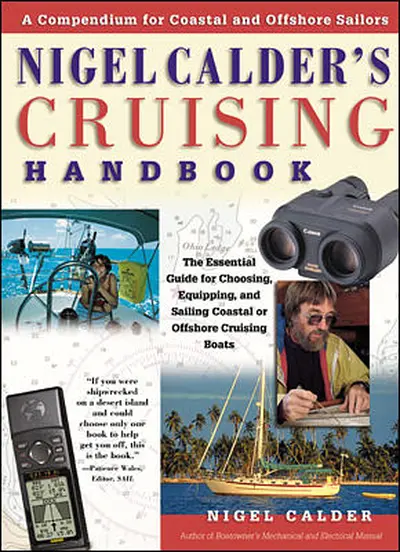My Account Details

ISBN10: 1265928231 | ISBN13: 9781265928230

Step 1 . Download Adobe Digital Editions to your PC or Mac desktop/laptop.
Step 2. Register and authorize your Adobe ID (optional). To access your eBook on multiple devices, first create an Adobe ID at account.adobe.com. Then, open Adobe Digital Editions, go to the Help menu, and select "Authorize Computer" to link your Adobe ID.
Step 3. Open Your eBook. Use Adobe Digital Editions to open the file. If the eBook doesn’t open, contact customer service for assistance.
The most comprehensive and helpful guide ever written for selecting and equipping a cruising sailboat
Whether you’re a coastal or offshore cruiser, you’ll find your most pressing concerns treated with the know-how that makes for skillful, confident cruising in Nigel Calder’s Cruising Handbook. The author -- one of the most respected marine how-to authors on either side of the Atlantic, and author of the universally admired Boatowner's Mechanical and Electrical Manual, -- walks you through all key technical and practical aspects of modern cruising systems and equipment, providing you with a summary of the skills necessary for safe, enjoyable sailing.
The first half of the book includes an easy-to-use tabular method for evaluating a boat's suitability for cruising; ideas for workable deck and interior lay-outs and organization; how to choose and configure suitable boat systems for cruising; and how to install gear for trouble free operation.
The book's second half teaches you boat handling skills; core navigational expertise; anchoring techniques; weather understanding; heavy weather expertise; and specific skills for long-term and long-distance cruising.
Front Matter
Preface
Acknowledgments
Introduction
Part One: The Boat
Chapter 1. A Boat for Cruising
Basic Design Parameters
Length-Beam Ratio; Keel Types; Displacement Calculations; Ballast Ratio; Displacement-Length Ratio; Overhangs; Waterplanes and Immersion; Comfort Factor; Sail Area-Displacement Ratio; Stability Curves and Ratio; Capsize Screening Value and STIX Number; Maintaining Control; Speed-Length Ratio; Buttocks, Diagonals, and Aft Sections; Speed versus Comfort
Getting Down to Details
Construction Materials; Cored Hulls and Decks; Hull-to-Deck Joints; Structural Reinforcements; Keels; Rudders and Skegs; Skegs and Propellers; Bilge Water and Tankage
Conclusion
Chapter 2. On Deck
Rigs and Rigging
Rig Options; Masts, Spreaders, and Shroud Angles; Holding Up the Mast; Roller-Reefing Foresails; Mainsail; Odds and Ends
Cockpits and Deck Layout
Center or Aft Cockpit; Basic Parameters and the Comfort Factor; Steering; Dodgers and Biminis; Cockpit Flooding; Deck Design and Layout; Stowage
Dealing with Ground Tackle
Bow Platform; Deck Layout; Anchor Wells; Chain Locker; Windlasses
Addendum: Carbon Fiber Masts
Lightning and Other Survival Issues
Chapter 3. Cruising Accommodations: Fusing Functionality at Sea with Comfort on the Hook
General Considerations
Minimizing Motion; Keeping Things in Place; Insulation; Ventilation; Air Conditioning and Heating
Specific Spaces
Navigation Station; Wet Locker; Galley; Saloon; Forecabins, Quarter Berths, and Aft Cabins; Head Compartment
Conclusion
Addendum: Carbon Monoxide Poisoning
Carbon Monoxide Alarms
Chapter 4. Electrical Systems
A Balanced System
Keeping the Load Down; The Supply Side; Supplementary Sources of Power; Defining the Limits; Miscellaneous DC Systems Issues
DC to AC Inverters
Sizing an Inverter; DC and AC Installations
Over-Current Protection and High-Current Circuits
What Size Fuse or Circuit Breaker?; High-Current Circuits; Check Your Own Boat
Low-Energy Refrigeration
Efficiency; Versatility; Insulate, Insulate, Insulate; Enhancing Performance; Effective Refrigeration
Low-Energy Lighting
Fluorescent Lights; LED Lighting; Halogen Lights
AC Systems
Safety; Corrosion; Miscellaneous AC Systems Comments
Bonding, Zinc Anodes, and Lightning Protection
Stray-Current Corrosion and Bonding; Lightning Protection
Conclusion
Chapter 5. The Rest of the Systems
The Engine and Propeller
How Big an Engine?; Propeller Sizing; Propeller Matters; Peripheral Systems; Living with an Engine
Fuel and Water Tanks
Metal Tanks; Plastic Tanks; Freshwater Systems; Watermakers
Bilge Pumps
Flooding Rates and Pumping Capacities; Improving Performance: Hoses and Check Valves; Improving Performance: Electrical Considerations; Float Switches; Keeping Dry Below Decks
Through-Hulls, Seacocks, and Hoses
Quality Through-Hulls and Seacocks; Hoses
Propane Installations
The Problem of Refills When Cruising
Making Equipment Choices
What Spares to Carry?
Chapter 6. Acquisition Strategies
Defining Priorities
What Size Boat?; To Build or Not to Build; Commissioning Costs
Used-Boat Market
Refurbishing an Older Sailboat; Old Racing Boats; A Survey; Go Sailing as Soon as Possible!
Cruising-Boat Questionnaire and Checklist of Desirable Features
Part Two: Cruising Skills
Chapter 7. Boat Handling under Power and Sail
Maneuvering under Power
Close Quarters Maneuvering under Power; Docking (Mooring) Lines; Docking Situations; The Medi
Need support? We're here to help - Get real-world support and resources every step of the way.